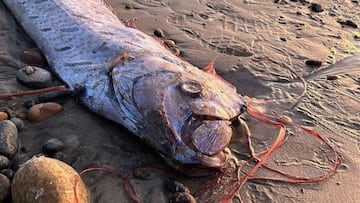Mysterious deep-sea giant washes ashore in California: could it hold clues to Earth’s hidden secrets?
The deep-sea oarfish, a harbinger of bad news, has been spotted again on the coast of California.

A rare 9-foot oarfish, often called the “sea serpent,” was discovered washed up on Grandview Beach in Encinitas, California, on November 6. This marks the third sighting of such a creature in the last three months and the 22nd in the past century. Alison Laferriere, a researcher from the Scripps Institution of Oceanography at the University of California, San Diego, made the unusual find.
The deceased specimen has been transported to the Southwest Fisheries Science Center for further study.
“We’ve collected samples and frozen the specimen for deeper analysis and eventual preservation in our Marine Vertebrate Collection,” explained Ben Frable, manager of the Scripps Oceanography Marine Vertebrate Collection.
A 9-foot oarfish, known as the "doomsday fish," was discovered in Encinitas, California, marking the third time this rare species has been spotted in the state this year.
— The Weather Network (@weathernetwork) November 20, 2024
Watch more video: https://t.co/LlPvrdCcd6 pic.twitter.com/G185DXM8e1
Myth or science? The Japanese legend of the oarfish
In Japanese mythology, the oarfish is believed to be an omen of impending natural disasters such as earthquakes or tsunamis. This belief gained attention in 2010 when multiple oarfish sightings were reported in Japan, shortly before the catastrophic 2011 earthquake.
Some theories suggest that tectonic movements during earthquakes may kill these deep-sea creatures, causing them to surface on beaches. However, a 2019 GeoScience study found no scientific correlation between oarfish appearances and seismic activity.
The elusive deep-water oarfish – considered to be a harbinger of bad news – was spotted yet again on the shores of Encinitas, California. https://t.co/4i12uLRSmA pic.twitter.com/xf9KYtNjHY
— AccuWeather (@accuweather) November 19, 2024
The “Doomsday Fish” and its hidden realm
Oarfish are elusive, rarely seen alive due to their habitat deep within the mesopelagic zone—around 3,000 feet below the ocean’s surface. With a ribbon-like silver body that can stretch up to 30 feet, oarfish have long fueled myths about sea monsters. Scientists remain intrigued by their biology and behavior.
“This specimen, like others before it, provides a unique opportunity to study the biology, anatomy, genomics, and life history of the oarfish,” said Frable.
In September, another oarfish was found at Huntington Beach, though in a degraded state. The reasons behind these strandings remain unclear. “It could be related to changing ocean conditions or an increase in oarfish along our coasts,” Frable noted. He also pointed out that this particular stranding coincided with recent red tides and the Santa Ana winds.
Divers discover giant 'Doomsday Fish' off the coast of Taiwan pic.twitter.com/lltwWK4mq8
— Historic Vids (@historyinmemes) February 4, 2024
Unlocking deep-sea mysteries
Scientists are seizing the opportunity to study these rare creatures, aiming to uncover insights about their survival strategies and the extreme environments they inhabit. “This oarfish offers a chance to collect fresh samples for genomic analysis,” explained marine biologist Dahiana Arcila, curator of the Marine Vertebrate Collection. “These studies could reveal the evolutionary adaptations that allow this species to thrive in the deep ocean.”
As researchers continue to analyze the specimen, they hope to shed light on not only the mysterious oarfish but also the hidden wonders of Earth’s unexplored marine depths.
Related stories
Article by Luis Méndez. Translated with the assistance of AI and edited by Calum Roche.
Get your game on! Whether you’re into NFL touchdowns, NBA buzzer-beaters, world-class soccer goals, or MLB home runs, our app has it all. Dive into live coverage, expert insights, breaking news, exclusive videos, and more – plus, stay updated on the latest in current affairs and entertainment. Download now for all-access coverage, right at your fingertips – anytime, anywhere.
Complete your personal details to comment